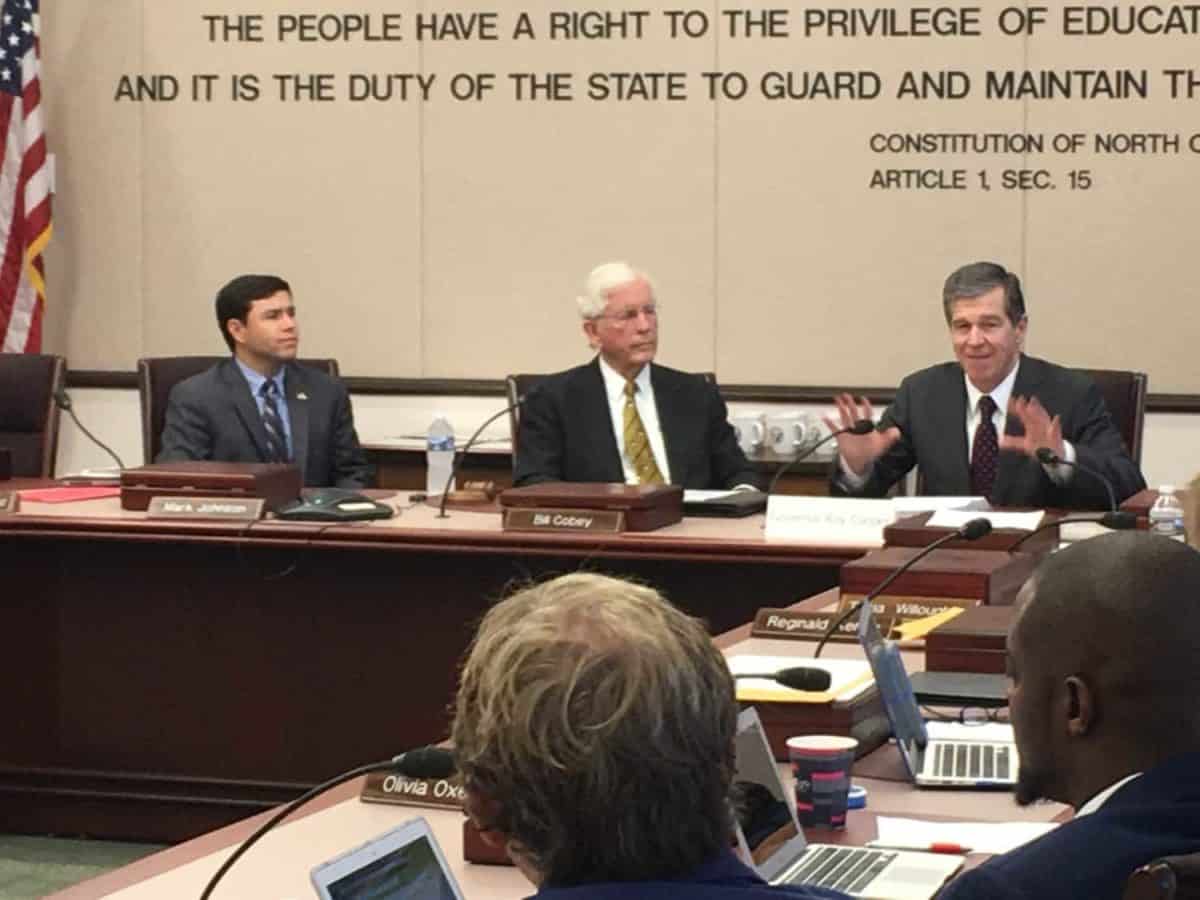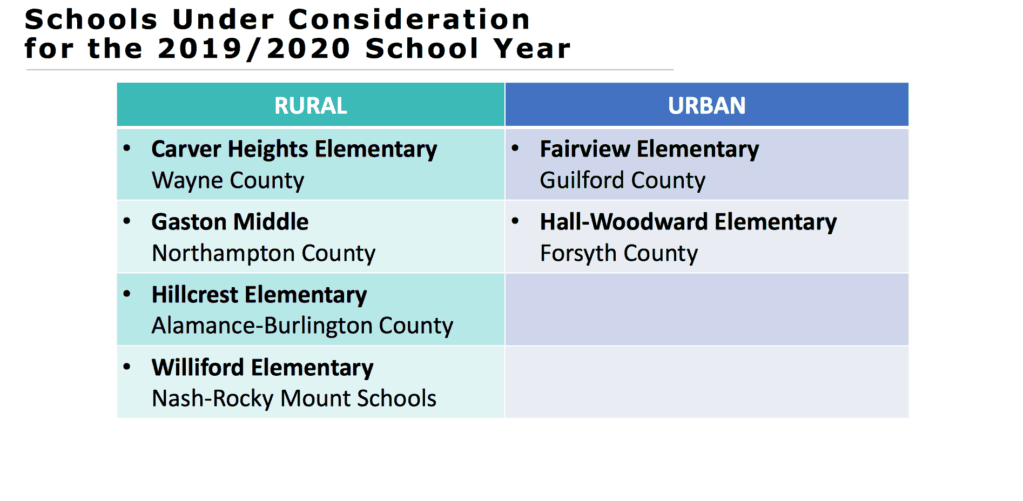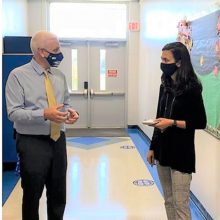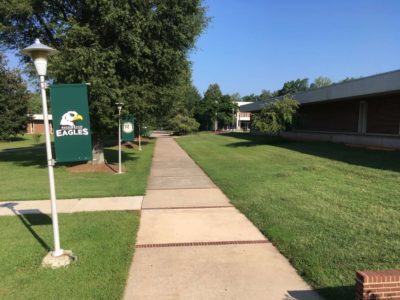
The State Board of Education meeting this month was packed full of news, between the release of the annual School Performance Grades, the announcement of schools that could potentially join the Innovative School District, and continued strife between the State Board and Superintendent Mark Johnson. Here’s a rundown of what happened.
State Board strife
The conversation between Superintendent Mark Johnson and State Board of Education members got heated a number of times during the first day of the Board meeting. It began with questions over $6 million that Johnson used to purchase iPads for every reading teacher in the state. Johnson said the money was Read to Achieve funding leftover from 2016 that was meant to go to the classroom but never did.
An article by Billy Ball of NC Policy Watch also raised concerns about the process by which the iPads were purchased and an expenditure by Apple of more than $5,300 to bring Johnson and others to visit the company’s headquarters in Silicon Valley.
On Wednesday, Board Co-Chair Eric Davis expressed his displeasure with the fact that the State Board wasn’t informed about the purchases.
“It’s embarrassing to have constituents ask about a major DPI purchase of iPads for reading teachers after the fact,” he said. “Why weren’t we informed?”
At the Board meeting, Johnson pleaded for cooperation between the Board and himself.
“I’ve moved on, the Department’s moved on. We are happy to work with you on these things that we are accomplishing,” he said.
There has been tension between the Board and Johnson ever since he came into office and the General Assembly passed House Bill 17, which transferred some of the State Board’s powers to Johnson. The Board sued over the legislation, ultimately losing at the Supreme Court. Since then, Johnson has reorganized the State Department of Public Instruction (DPI) and taken the Board out of the loop when it comes to decisions regarding DPI.
The back and forth continued, with various State Board members challenging Johnson’s decision and the fact that he didn’t tell the Board about the purchase ahead of time. Johnson suggested that this kind of tense discussion shouldn’t take place at official Board meetings.
“I just want to stop what’s happening here. Why are we having this back and forth at a Board meeting?” he asked. “You have my cell phone number, you have my email. This is not good for the department. It’s not good for North Carolina public schools.”
Board member Wayne McDevitt said that the discussion was necessary for transparency’s sake and so that the public knew what was going on.
“The discussion needs to begin at this table so that people feel comfortable,” he said.
Board member Greg Alcorn said that the State Board would look at its process going forward.
“We will reflect on our process and make sure that we ask the right questions and have the right info as far as purchases are concerned,” he said. “We will look at contract rules and bring those back in October.”
The debate started up again during a segment of the meeting devoted to the adoption of new policies by the State Board. Legislation in the short session of the General Assembly got rid of the old rules governing the Board, necessitating the adoption of new ones. The Board took up policies this week related to its responsibilities, the Superintendent’s duties in regards to licensure, the structure of DPI, and more.
At one point, Johnson got some pushback on his organizational chart with members of the State Board suggesting that “essential” employees be identified on the chart. Johnson said he thought it was bad for Department morale to make an official listing of who was “essential,” and who was not.
“I’m not going to engage in back and forth. I think it’s petty. I think the board should be above it. It’s not good for the department. We went through the lawsuit, it took a year and a half, people are ready for us to show leadership and move on. I am ready to work together with you based on the new confines after the court case,” he said.
Board member Patricia Willoughby struck back, saying that working together is a good idea, but that Johnson isn’t doing that.
“I believe that working together would be the optimal way to do this. Just as recently as yesterday, there’s an announcement on school safety. We were not invited. I looked at the poster and there are lots of entities listed that are collaborating. Notably absent is the State Board,” she said.
On Tuesday, Johnson held a press conference announcing September as School Safety Month. No members of State Board were in attendance. On the second day of the State Board meeting, Johnson said he would add the State Board as a partner on the school safety poster Willoughby referenced.
Johnson continued to express his frustration with the rules the State Board was planning to adopt, including one that would require DPI staff to submit any remarks they’re going to give publicly to the State Board ahead of time.
“Let’s stop the back and forth,” Johnson said. “Draft these rules in public instead of just putting them all in.”
The debate continued during a discussion about testing, with some Board members saying that Johnson has said that the State Board is, in part, responsible for over-testing and that he is going to urge them to decrease the burden on students.
“Show us what we can unilaterally change, and we will do it,” said Davis. “But if it depends on an act of the General Assembly, that’s where we have to start.”
School Performance Grade release
The State Department of Public Instruction released the School Performance Grades on Wednesday, the first day of the State Board meeting. The grades label schools with an A-F letter grade, using a formula that is 80 percent academic achievement and 20 percent academic growth.

As can be seen in the chart above, 7.3 percent of the state’s 2,537 schools received an A, while 28.3 percent received a B. Forty-two point two percent received a C. Eighteen point six percent received a D, and 3.6 percent received an F.
The state’s two virtual charter schools continue to get Ds without meeting growth.
For 2017-18, there were 476 low performing schools. These are schools that get a D or F and don’t exceed growth. The total number of low performing schools is down slightly from 2016-17, when there were 505. The number of low performing districts fell to seven from 11 in 2016-17. Low performing districts are districts where the majority of the schools are low performing. The number of recurring low-performing schools fell to 435 from 468.
These school grades have often been criticized as measures of poverty, since schools where the majority of students are low-income tend to do the worst. This release continued to follow that trend, with 69 percent of schools where more than 81 percent of students are from low-income families receiving a D or F. In schools where the percent of students that come from low-income families is between 61 and 80 percent, 45 percent of the schools got a D or F. In schools where the percent of students from low income families is less than 20 percent, 1.7 percent received a D or F.
Twenty-seven percent of schools exceeded expected growth, 45.7 percent met growth, and 27.3 did not meet growth.
For the first time in years, the graduation rate for North Carolina’s public schools fell. The rate for 2017-18 was 86.3 percent, down from 86.5 percent the previous year.
According to DPI, the changes in accountability measurements due to the federal Every Student Succeeds Act make it impossible to compare this year’s scores, growth results, and graduation rates to previous years.
Innovative School District
Eric Hall, Superintendent of the Innovative School District (ISD) presented the list of schools that could possibly be chosen to be the next to join the ISD. The Innovative School District, at its most basic level, is a program that will ultimately take five of the lowest-performing schools in the state and put them in a virtual district. The schools will still be located where they are currently, but they will be taken over by outside operators, which could include for-profit charter or education management organizations. The schools will have charter-like flexibility and the district will be overseen by the ISD, with Hall as its superintendent.
The first school chosen for the district was Southside Ashpole in Robeson County, which began its tenure in the ISD this fall. It is being run by Charlotte-based Achievement for All Children.
The following schools are up for consideration.

By statute, Hall is required to have two more schools start in the ISD next year, so at least two of these schools will enter the ISD process. Hall said he has until October 15th to notify the districts if one of their schools is chosen and will bring recommendations to the State Board in November.
State Board Departures
For Board Chair Bill Cobey and Board members Greg Alcorn and Becky Taylor, this week was the final week they are serving on the State Board of Education. Acting Vice Chair Eric Davis was elected Thursday by the Board to be chair and relative newcomer, Alan Duncan, was elected to be vice chair. See comments from Cobey, Taylor and Alcorn below.
Governor’s Appearance
Thursday, Governor Roy Cooper visited the State Board for the first time since he was elected, taking some time at the beginning of the meeting to outline his vision for education and to say some words about the State Board and its members. See the video of his remarks below.



